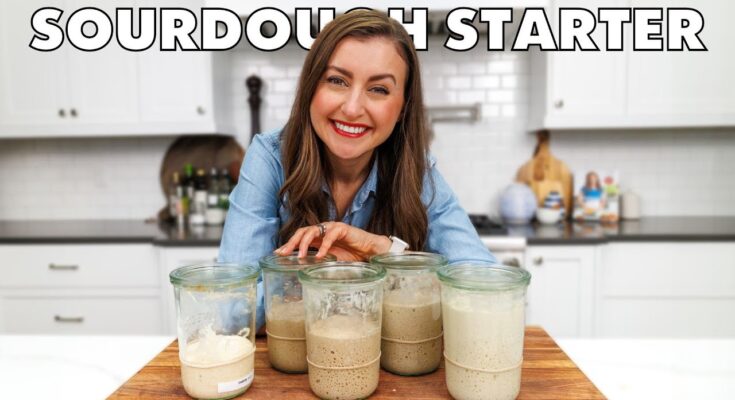Sourdough Starter Recipe: Making a sourdough starter from scratch might sound intimidating, but it’s easier than you think! With just two basic ingredients, a bit of patience, and some care, you’ll have a healthy starter ready to bake flavorful sourdough bread.
In this guide, I’ll walk you through the process step-by-step. Whether you’re a seasoned baker or a beginner, this recipe has everything you need to succeed.
What is a Sourdough Starter?
A sourdough starter is a natural leavening agent made from flour and water. It captures wild yeast and beneficial bacteria from the environment, which ferment the mixture. Unlike commercial yeast, the starter grows over time and gives sourdough bread its unique tangy flavor and chewy texture.
Why is a Sourdough Starter Important?
The starter is essential for creating traditional sourdough bread. It’s what makes the bread rise naturally, without the need for store-bought yeast. Besides leavening, it contributes to the bread’s characteristic sour taste and aroma.
Ingredients Required for a Sourdough Starter
Here’s the best part: you only need two ingredients!
- Unbleached All-Purpose Flour (or Whole Wheat Flour)
- Filtered Water
Whole wheat or rye flour is often used for the first few days, as it helps kickstart fermentation due to higher nutrient levels. However, all-purpose flour works well too.
Equipment You’ll Need
- A Clean Glass Jar or Container
- Measuring Cups or Digital Scale
- Spoon or Silicone Spatula
- A Clean Towel or Cheesecloth (to cover the jar)
Optional but helpful: A rubber band to mark the starter’s growth.
How to Make a Sourdough Starter – Step-by-Step Process
Day 1: The Initial Mixture
- Combine ½ cup flour and ¼ cup water in a jar.
- Mix well until it forms a thick paste.
- Cover with a cloth to allow airflow but prevent contamination.
- Leave the jar at room temperature for 24 hours.
Day 2: Checking for Bubbles and Feeding the Starter
- After 24 hours, check for small bubbles. Bubbles mean fermentation has begun!
- Discard half the starter and feed it with ½ cup flour and ¼ cup water.
- Stir and cover again.
Days 3-5: Strengthening the Starter
- Keep feeding the starter once every 24 hours by discarding half and adding fresh flour and water.
- By Day 5, the starter should look bubbly and double in size within a few hours of feeding.
Feeding the Starter – Why and How Often?
Feeding is like giving your starter “food” to keep the yeast and bacteria active. For the first week, daily feeding is essential. After it stabilizes, you can reduce feeding to once every 12-24 hours, depending on usage and storage.
Troubleshooting Common Issues
No Bubbles or Activity
- Try using whole wheat or rye flour for a couple of days.
- Ensure the water is at room temperature – too cold, and fermentation slows down.
Starter Smells Unpleasant
A mild sour smell is normal, but if it smells like rotten cheese, discard it and start over.
Too Runny or Too Thick
Adjust the water or flour to maintain a pancake batter consistency.
How to Know When Your Starter is Ready to Use
A mature starter will double in size a few hours after feeding and have a pleasant, slightly tangy smell. To confirm, try the float test: Drop a spoonful of starter into water – if it floats, it’s ready to bake!
How to Store Your Sourdough Starter
Short-Term Storage
If you bake regularly, leave your starter at room temperature and feed it daily.
Long-Term Storage
For occasional baking, store the starter in the fridge and feed it once a week. You can also freeze it for months!
Using Your Sourdough Starter for Baking
Once your starter is active, you can use it in various recipes:
- Classic sourdough bread
- Pancakes
- Pizza dough
- Muffins
The flavor of sourdough develops over time, giving the bread a unique depth you won’t find with regular yeast.
How to Revive a Dormant or Weak Starter
If your starter has been neglected, don’t worry! Discard most of it, leaving just a small portion. Feed it with fresh flour and water over a few days, and it should come back to life.
How to Maintain a Healthy Sourdough Starter Long-Term
Keep an eye on your starter’s smell and activity. Feed it regularly and adjust feeding frequency based on temperature and baking needs. Avoid metal containers, as they can interfere with fermentation.
How to Share or Gift Sourdough Starter
Sharing your starter is a fun way to spread the love of baking. Package some starter in a small jar and include feeding instructions for the recipient. It’s like passing on a little piece of baking history!
FAQs about Sourdough Starter Recipe
1. What is a sourdough starter?
A sourdough starter is a fermented mixture of flour and water that serves as a natural leavening agent for bread. It contains wild yeast and beneficial bacteria, giving sourdough its signature tangy flavor.
2. How long does it take to make a sourdough starter?
Creating a sourdough starter usually takes 5-7 days. During this time, the mixture needs daily feeding and proper storage at room temperature to develop active yeast.
3. What kind of flour is best for sourdough starter?
While all-purpose flour works fine, using whole wheat or rye flour can boost the fermentation process, as they contain more natural yeast and nutrients.
4. How do I know if my sourdough starter is ready to use?
A ready starter will double in size within 4-6 hours of feeding, have a bubbly surface, and give off a slightly tangy, fruity smell. You can also do the float test—drop a spoonful of starter in water. If it floats, it’s ready!
5. Can I store my sourdough starter in the fridge?
Yes! Once your starter is active, you can store it in the refrigerator and feed it weekly to maintain it. Bring it back to room temperature and feed it a couple of times before baking.
6. Why isn’t my starter bubbling or growing?
Lack of activity could result from insufficient feeding, cold temperatures, or low-quality flour. Try switching to whole grain flour or keeping the starter in a warmer spot.
7. How do I feed my sourdough starter?
Feeding involves discarding half of the starter and replenishing it with equal parts of flour and water. This process ensures the yeast stays healthy and active.
8. What is the best way to use sourdough discard?
Sourdough discard can be used in pancakes, waffles, crackers, or pizza dough, minimizing waste and adding flavor to your dishes.
Conclusion
Creating a sourdough starter from scratch is a rewarding experience. It’s amazing how just flour, water, and time can create a powerful leavening agent for delicious baked goods. With proper care and regular feeding, your starter will continue to thrive and provide you with delicious bread for years to come.
References
For further reading and to validate the information provided in our Sourdough Starter Recipe with Post Links, here are some reputable sources:
- King Arthur Baking – A trusted name in baking, offering expert tips on sourdough starter maintenance.
- The Perfect Loaf – A comprehensive guide from a seasoned baker, sharing advanced insights on fermentation and troubleshooting.
- Breadtopia – Known for its step-by-step tutorials on artisan bread-making and practical starter care advice.
These resources provide additional expertise, helping you refine your sourdough skills and expand your baking knowledge.



